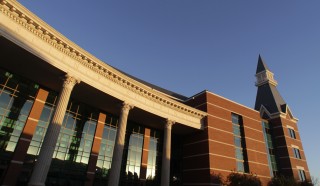
Lariat File Photo
By Linda Wilkins
Staff Writer
A U.S. patented technology that simplifies sugar analysis has been created by four Baylor researchers and is currently available to license.
The patent is for an instrument called a polarimeter, which can potentially lower the costs of producing and analyzing sugar.
Polarimeters analyze the purity of sugar solutions and can determine the concentrations of the sugar in the solutions, Dr. Dennis Rabbe, Baylor chemistry laboratory coordinator, said.
Rabbe, Drs. Kenneth and Marianna A. Busch, both Baylor Emeritus professors of chemistry, and former graduate student Carlos Celleja-Amador developed this new polarimeter and the process of using it to analyze sugar.
Conventional polarimeters, still largely in use today, often need to add chemicals to the samples in order to analyze them, Kenneth Busch said.
These polarimeters analyze samples with the rotation of light, but the impurities in the samples make the process difficult because the light cannot penetrate the sample, he said.
Some samples are dark in color, like brown sugar, and in order to analyze these samples, lead is added to remove the impurities causing the dark color, he said.
“The price of analyzing the samples becomes very high because the lead has to be removed,” Kenneth said. “Our instrument can avoid that.”
This is because the new polarimeter does not need to remove the impurities of the samples, he said.
Rabbe said the instrument uses multiple wavelengths of light in order to examine the solution on various levels of light. Ordinary polarimeters only use one, redder wavelength of light, and this is the reason impurities, that cause dark coloring to the solution interfere with analysis, he said.
“It’s a novel type of polarimeter that solves some analytical problems that will hopefully be used as a commercial product,” Rabbe said.
Marianna Busch said the instrument the four researchers designed avoids having to add chemicals, such as lead, to the samples because of the various wavelengths the instrument can use.
She also said this new instrument could have applications in various countries.
“This is potentially very important because raising sugar cane is a major industry throughout the world, but in many countries the sugar is not being used to its full potential because the sugar is still discolored,” she said.
Kenneth Busch said the process of obtaining the patent was long and drawn out.
Once the researchers completed and refined their idea, they had to write a report called a disclosure that explained the details of the idea, he said.
The disclosure was sent to the lawyers at Baylor, who had a committee that determined whether the university would want to submit the idea to the patent office.
“Once you clear that hurdle, you submit an application to the patent office and explain what your idea is,” Kenneth Busch said. “But it has to be novel — a major idea, a new idea.”
Though it took several years to have the patent approved, it was finally approved in September, he said.






